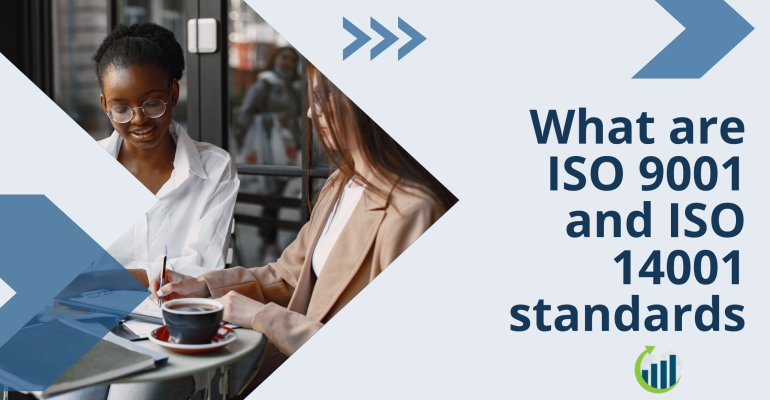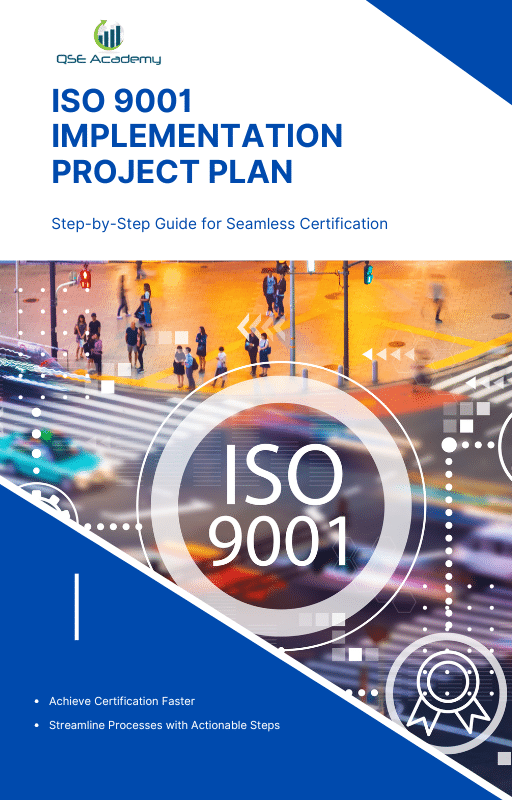What are ISO 9001 and ISO 14001 standards?
What are ISO 9001 and ISO 14001 Standards?
Have you ever wondered how some organizations manage to consistently deliver high-quality products and services while also being environmentally responsible? The answer often lies in adhering to internationally recognized standards like ISO 9001 and ISO 14001.
ISO 9001 and ISO 14001 are two of the most widely adopted standards, designed to help organizations enhance their quality management and environmental practices. They’re not just about ticking boxes; they’re about creating systems that improve processes, build trust, and make a positive impact.
In this article, we’ll break down what these two standards are all about, why they matter, and how they can benefit organizations like yours. Whether you’re new to ISO or looking to expand your knowledge, this guide will make it simple and straightforward. Let’s dive in!
What is ISO 9001?
Let’s start with one of the most popular standards: ISO 9001. If you’ve ever heard people talk about quality management systems (QMS), chances are they were referring to this standard. ISO 9001 provides a framework that helps organizations deliver consistent, high-quality products and services that meet customer expectations.
The Purpose of ISO 9001
At its core, ISO 9001 is all about putting the customer first. It ensures that businesses have systems in place to meet customer needs reliably, whether that’s through efficient processes, well-trained staff, or continuous improvement initiatives.
Think of it like building a strong foundation for your business. With ISO 9001, you’re not just focusing on quality for the short term—you’re creating a system that helps your organization maintain and improve quality over time.
Example:
A manufacturing company might use ISO 9001 to streamline production, reduce defects, and ensure that every product leaving the factory meets strict quality standards.
Key Principles of ISO 9001
To truly understand ISO 9001, it helps to look at the principles behind it. These are the building blocks of the standard and guide how businesses should approach quality management:
- Customer Focus: Meeting and exceeding customer expectations is a top priority.
- Leadership: Strong leadership ensures everyone in the organization is aligned with quality goals.
- Engagement of People: Employees at all levels are involved and committed to maintaining quality.
- Process Approach: Efficiency comes from managing activities as interconnected processes.
- Improvement: Continuous improvement is the goal, always striving to get better.
- Evidence-Based Decision Making: Decisions are based on data and analysis, not guesswork.
- Relationship Management: Building strong relationships with suppliers and stakeholders ensures success.
Example:
A tech startup adopting ISO 9001 might focus on customer feedback to refine its software, ensuring each new update addresses users’ needs and improves satisfaction.
Who Benefits from ISO 9001?
One of the great things about ISO 9001 is that it’s designed to work for any organization, regardless of its size or industry. From small businesses to multinational corporations, anyone can use this standard to improve quality.
Industries That Commonly Use ISO 9001:
- Manufacturing: To ensure consistent production quality.
- Healthcare: To maintain high standards in patient care.
- Education: To deliver better learning experiences.
- Retail: To improve customer service and product availability.
Example:
A small bakery could implement ISO 9001 to create a more organized process for sourcing ingredients, training staff, and ensuring every loaf of bread meets the same high standard.
Why ISO 9001 Matters
When you implement ISO 9001, you’re not just meeting a standard—you’re transforming how your business operates. It’s a practical, flexible approach to improving quality in a way that benefits both your customers and your bottom line.
Now that we’ve covered ISO 9001, let’s move on to its environmental counterpart: ISO 14001. This one is all about helping businesses minimize their environmental impact, and trust me, it’s just as valuable. Let’s explore!
What is ISO 14001?
Now that we’ve talked about ISO 9001 and how it focuses on quality, let’s switch gears to ISO 14001, the standard that helps organizations manage their environmental impact. If you’ve ever wondered how businesses can operate sustainably while meeting regulatory requirements, ISO 14001 is the answer.
The Purpose of ISO 14001
At its core, ISO 14001 is all about helping organizations create an environmental management system (EMS). This system is designed to reduce environmental harm, improve sustainability, and ensure compliance with environmental laws and regulations.
Think of it as a roadmap for businesses that want to be more eco-friendly. With ISO 14001, you’re not just minimizing your environmental footprint—you’re also demonstrating a commitment to protecting the planet.
Example:
A construction company might use ISO 14001 to manage waste disposal, minimize pollution, and improve energy efficiency on job sites.
Key Principles of ISO 14001
Just like ISO 9001 has its guiding principles, ISO 14001 is built on several key concepts that drive its implementation:
- Environmental Policy: Establishing a clear policy that outlines the organization’s commitment to sustainability.
- Compliance Obligations: Ensuring all activities meet relevant environmental laws and regulations.
- Risk and Opportunity Management: Identifying and addressing environmental risks and opportunities.
- Lifecycle Perspective: Considering the environmental impact of products and services from creation to disposal.
- Continuous Improvement: Regularly reviewing and improving the environmental management system.
Example:
A packaging company might adopt a lifecycle perspective by switching to biodegradable materials to reduce the environmental impact of its products.
Why Organizations Adopt ISO 14001
Businesses adopt ISO 14001 for a variety of reasons, and the benefits go beyond just meeting regulations. Here are some of the top reasons why organizations implement this standard:
- Sustainability Goals: To reduce waste, energy consumption, and overall environmental impact.
- Regulatory Compliance: To stay ahead of changing environmental laws and avoid penalties.
- Reputation and Trust: To show customers, employees, and stakeholders that the organization takes sustainability seriously.
- Cost Savings: To identify inefficiencies and save money by using resources more effectively.
Example:
A hotel chain might adopt ISO 14001 to reduce water usage, lower energy consumption, and attract environmentally conscious travelers.
Who Benefits from ISO 14001?
While ISO 14001 is particularly valuable for industries with a high environmental impact, such as manufacturing, construction, and energy, it’s also relevant for smaller businesses looking to improve sustainability.
Industries That Commonly Use ISO 14001:
- Agriculture: To reduce water usage and pesticide runoff.
- Energy: To manage emissions and improve renewable energy practices.
- Retail: To minimize waste from packaging and distribution.
- Hospitality: To adopt greener practices and appeal to eco-conscious guests.
Example:
A small café might use ISO 14001 to eliminate single-use plastics and transition to compostable cups and utensils.
Why ISO 14001 Matters
Implementing ISO 14001 isn’t just about being environmentally responsible—it’s also a smart business decision. It helps organizations operate more efficiently, meet customer expectations for sustainability, and stay ahead of regulations.
Now that we’ve covered both ISO 9001 and ISO 14001, let’s take a closer look at how these two standards are similar and how they can work together to create a more efficient and sustainable business.
ISO 9001 and ISO 14001: How Are They Similar?
Now that we’ve explored what ISO 9001 and ISO 14001 are all about, you might be wondering, “Do these two standards have anything in common?” The answer is yes! While one focuses on quality management and the other on environmental management, they share several similarities that make them easier to implement together. Let’s take a closer look.
One of the biggest reasons ISO 9001 and ISO 14001 work well together is that they both follow the same High-Level Structure (HLS). This framework provides a standardized format for ISO standards, making it easier to integrate multiple systems within your organization.
Key Benefits of the HLS:
- It uses common terminology, making it simple for teams to understand both standards.
- It allows businesses to manage their quality and environmental systems seamlessly.
- It reduces duplication, so you don’t have to create separate processes for each standard.
Example:
A manufacturing company might align its documentation processes for ISO 9001 and ISO 14001, ensuring consistency across both its quality and environmental management systems.
2. Focus on Continual Improvement
Another key similarity is the emphasis on continual improvement. Both ISO 9001 and ISO 14001 encourage organizations to regularly review their systems, identify areas for growth, and implement changes to drive progress.
How It Works for Both Standards:
- ISO 9001: Focuses on improving product or service quality to enhance customer satisfaction.
- ISO 14001: Focuses on improving environmental performance, such as reducing waste or energy consumption.
Example:
A logistics company certified for both ISO 9001 and ISO 14001 might improve delivery processes to ensure on-time shipments (quality) while optimizing routes to reduce fuel consumption (environmental impact).
3. Building Trust and Credibility
Whether you’re talking about quality or sustainability, both standards are designed to help organizations build trust with their customers, employees, and stakeholders. By demonstrating compliance with ISO 9001 and ISO 14001, you’re showing the world that your business prioritizes excellence and responsibility.
Why This Matters:
- Customers want to work with companies that consistently deliver high-quality products or services.
- Stakeholders value organizations that take environmental concerns seriously.
- Certification in both standards positions your business as reliable, forward-thinking, and globally competitive.
Example:
A tech company with certifications in both ISO 9001 and ISO 14001 can use them to showcase its commitment to innovation and sustainability, attracting clients who prioritize quality and eco-friendliness.
Why Their Similarities Matter
The shared framework, focus on continual improvement, and emphasis on building trust make ISO 9001 and ISO 14001 a natural pair. These similarities not only simplify the implementation process but also amplify the benefits when the two standards are integrated.
In the next section, we’ll explore the key differences between ISO 9001 and ISO 14001, so you can better understand how they complement each other. Let’s keep going!
ISO 9001 and ISO 14001: Key Differences
While ISO 9001 and ISO 14001 share some common ground, they serve very different purposes. Understanding their key differences can help you see how these two standards complement each other while addressing unique aspects of your business. Let’s break it down.
1. Quality vs. Environmental Focus
The most obvious difference is their focus: ISO 9001 centers on quality management, while ISO 14001 is all about environmental management.
- ISO 9001: Ensures your organization consistently delivers high-quality products or services that meet customer expectations.
- ISO 14001: Helps your organization minimize its environmental impact and comply with environmental regulations.
Example:
A car manufacturer might use ISO 9001 to ensure their vehicles meet safety and performance standards, while ISO 14001 would guide efforts to reduce emissions during production.
2. Objectives and Outcomes
Each standard has distinct objectives, which lead to different outcomes for your business.
- ISO 9001: Focuses on customer satisfaction, process efficiency, and reducing errors. The goal is to improve quality and reliability in every aspect of your operations.
- ISO 14001: Aims to improve sustainability, reduce waste, and manage resources responsibly. The focus is on being environmentally conscious and reducing your carbon footprint.
Example:
A food packaging company might implement ISO 9001 to ensure products are safe and meet regulatory requirements, while ISO 14001 would help them reduce plastic waste and switch to eco-friendly materials.
3. Applicability Across Industries
Both standards are versatile, but their relevance may vary depending on the industry.
- ISO 9001: Applies to virtually all organizations, regardless of their size or sector, because quality is a universal priority.
- ISO 14001: While any organization can adopt this standard, it’s particularly important for industries with significant environmental impacts, such as manufacturing, construction, and energy.
Example:
A consulting firm might benefit more from ISO 9001 to improve service delivery, while a chemical company would prioritize ISO 14001 to manage hazardous waste responsibly.
4. Stakeholder Priorities
The stakeholders you aim to satisfy might differ depending on which standard you’re focusing on.
- ISO 9001: Customers are the main priority. Meeting their needs and ensuring satisfaction is the ultimate goal.
- ISO 14001: The focus extends beyond customers to include regulators, environmental groups, and the broader community.
Example:
A retail business might adopt ISO 9001 to improve customer service and ensure product consistency. If they also adopt ISO 14001, they’re demonstrating responsibility to environmental organizations and consumers who value sustainability.
Why Understanding the Differences Matters
Recognizing the differences between ISO 9001 and ISO 14001 can help you decide which standard to implement based on your organization’s priorities—or how to integrate both for a comprehensive approach.
In the next section, we’ll explore how combining these two standards can create powerful synergies, making your business both efficient and sustainable. Let’s keep the conversation going!
Benefits of Implementing ISO 9001 and ISO 14001 Together
If ISO 9001 helps you deliver consistent quality and ISO 14001 ensures environmental responsibility, imagine the possibilities when you combine the two. Implementing ISO 9001 and ISO 14001 together creates a powerful system that not only boosts efficiency but also positions your business as a leader in quality and sustainability. Let’s explore the benefits of integrating these two standards.
1. Streamlined Processes
One of the biggest advantages of adopting both ISO 9001 and ISO 14001 is the ability to streamline your processes. Because both standards share the same High-Level Structure (HLS), integrating them becomes much easier.
How This Helps:
- You can develop a single management system that covers both quality and environmental goals.
- There’s less duplication of effort—one audit or review can address requirements for both standards.
- It saves time and resources, allowing you to focus on running your business.
Example:
A manufacturing company might integrate its quality control process (ISO 9001) with its waste management system (ISO 14001), ensuring products meet high standards while minimizing environmental impact.
2. Enhanced Reputation
In today’s competitive market, customers and stakeholders care about more than just the quality of your products—they also want to know that you’re operating responsibly. Implementing ISO 9001 and ISO 14001 together shows that your business values both excellence and sustainability.
How It Builds Trust:
- Customers see your dual certification as a sign of reliability and responsibility.
- Stakeholders, including investors and partners, view your business as forward-thinking and ethical.
- It sets you apart from competitors who may only focus on one area.
Example:
A hotel certified with ISO 9001 and ISO 14001 can highlight its commitment to top-tier guest experiences and eco-friendly practices, making it more attractive to environmentally conscious travelers.
3. Cost Savings
While implementing either standard can lead to cost savings, combining ISO 9001 and ISO 14001 amplifies these benefits. How? By improving efficiency, reducing waste, and aligning processes, your organization can save money in multiple ways.
Ways to Save Costs:
- Streamlined processes mean fewer inefficiencies and errors, reducing rework and associated costs.
- Environmental initiatives, like reducing energy usage or waste, lower operational expenses.
- Optimized resource management reduces costs for materials, production, and logistics.
Example:
An e-commerce business could reduce packaging waste (ISO 14001) while improving order fulfillment processes (ISO 9001), leading to lower costs and happier customers.
4. Improved Employee Engagement
When employees see that their organization is committed to both quality and sustainability, it creates a sense of pride and purpose. Implementing ISO 9001 and ISO 14001 can boost employee engagement by involving them in meaningful initiatives.
How It Engages Employees:
- Employees are trained and empowered to contribute to quality and sustainability goals.
- Cross-functional teams can collaborate on projects that benefit both standards.
- A positive work environment is created, where everyone works toward shared goals.
Example:
A retail chain might involve employees in a program to reduce energy usage (ISO 14001) while also training them to improve customer service quality (ISO 9001).
5. Competitive Advantage
Incorporating both ISO 9001 and ISO 14001 into your business strategy gives you a significant edge in the market. It positions you as a company that not only delivers top-notch products and services but also cares about the environment.
Why It Gives You an Edge:
- Many clients and partners prioritize working with certified organizations.
- Governments and large corporations often require certifications when awarding contracts.
- It aligns your business with global trends favoring sustainability and accountability.
Example:
A construction firm with both certifications might win more bids by demonstrating its ability to deliver high-quality projects while adhering to strict environmental standards.
Why Combining ISO 9001 and ISO 14001 Matters
When you implement ISO 9001 and ISO 14001 together, you’re not just ticking two boxes—you’re creating a holistic approach to running a better business. Quality and sustainability go hand in hand, and together, they can help you achieve operational excellence, build trust, and make a positive impact.
In the next section, we’ll explore the practical steps to implement ISO 9001 and ISO 14001, so you can start seeing these benefits for yourself. Let’s keep going—you’re almost there!
Steps to Implement ISO 9001 and ISO 14001
By now, you’ve seen how powerful ISO 9001 and ISO 14001 can be, especially when implemented together. But how do you actually get started? Don’t worry—it’s more manageable than you might think. Whether you’re starting from scratch or integrating these standards into your existing systems, here’s a step-by-step guide to help you along the way.
1. Conduct a Gap Analysis
Before you dive into implementation, it’s important to know where you stand. A gap analysis helps you identify the areas in your current processes that need improvement to meet the requirements of ISO 9001 and ISO 14001.
How to Conduct a Gap Analysis:
- Review your existing quality management and environmental management practices.
- Compare them against the requirements of ISO 9001 and ISO 14001.
- Create a list of areas that need to be addressed, such as missing documentation, insufficient monitoring, or unclear objectives.
Example:
A logistics company might find that while their delivery process meets quality standards, they lack a clear plan for reducing fuel emissions to align with ISO 14001.
2. Develop Policies and Objectives
Both ISO 9001 and ISO 14001 require you to define policies and objectives that reflect your commitment to quality and sustainability. These should align with your organization’s goals and values.
What to Include in Your Policies:
- A quality policy that outlines your goals for customer satisfaction and product or service excellence (ISO 9001).
- An environmental policy that highlights your commitment to reducing your environmental impact (ISO 14001).
- Measurable objectives to track your progress in both areas.
Example:
A manufacturing company might set an ISO 9001 objective to reduce defective products by 10% and an ISO 14001 objective to lower energy consumption by 15%.
3. Train Your Team
Your employees play a key role in the success of ISO 9001 and ISO 14001. Training ensures that everyone understands their responsibilities and how their work contributes to the company’s quality and environmental goals.
How to Train Your Team:
- Conduct workshops or training sessions on the requirements of both standards.
- Provide role-specific training so employees know exactly how they can contribute.
- Foster a culture of openness where team members feel comfortable asking questions or sharing ideas for improvement.
Example:
A retail chain might train store managers on tracking customer satisfaction for ISO 9001 while also educating them on waste reduction strategies for ISO 14001.
4. Document Your Processes
Proper documentation is a cornerstone of both ISO 9001 and ISO 14001. Your policies, procedures, and records should be clear, accessible, and aligned with the standards.
What to Document:
- Quality management processes, like product inspections and customer feedback handling (ISO 9001).
- Environmental management activities, such as waste disposal and energy monitoring (ISO 14001).
- Records of audits, corrective actions, and continuous improvement initiatives.
Example:
A tech company might document their software testing process for ISO 9001 and create a log of e-waste recycling efforts for ISO 14001.
5. Monitor and Review Progress
Implementation isn’t a one-and-done effort—it’s an ongoing process. Regular monitoring and reviews help ensure your systems stay effective and aligned with ISO 9001 and ISO 14001.
How to Monitor Progress:
- Use key performance indicators (KPIs) to track quality and environmental performance.
- Conduct internal audits to identify areas for improvement.
- Schedule management reviews to assess progress and set new objectives.
Example:
A healthcare clinic might review patient satisfaction scores (ISO 9001) and energy usage reports (ISO 14001) quarterly to identify trends and opportunities for improvement.
6. Engage an External Auditor
Once your systems are in place, it’s time to bring in an external auditor to evaluate your compliance with ISO 9001 and ISO 14001. The auditor will review your documentation, processes, and performance to determine if you’re ready for certification.
Tips for Working with Auditors:
- Be transparent and provide all requested documents.
- Involve your team in the audit process to demonstrate their understanding of the systems.
- Use the auditor’s feedback as an opportunity to refine your processes.
Example:
A hotel preparing for certification might work closely with an auditor to ensure both its guest services (ISO 9001) and energy efficiency initiatives (ISO 14001) meet the required standards.
Why Following These Steps Matters
Implementing ISO 9001 and ISO 14001 might seem like a big task, but breaking it into manageable steps makes it achievable. By conducting a gap analysis, training your team, and monitoring your progress, you’re setting yourself up for long-term success in quality and sustainability.
In the final section, we’ll wrap up by reflecting on the importance of ISO 9001 and ISO 14001 and why they’re worth the effort. Let’s bring it all together!
Conclusion: Why ISO 9001 and ISO 14001 Matter
By now, you’ve learned how ISO 9001 and ISO 14001 can transform your organization, whether by ensuring consistent quality or reducing environmental impact. These standards aren’t just checkboxes for compliance—they’re tools that empower businesses to improve, grow, and make a meaningful impact.
Why ISO 9001 and ISO 14001 Are Worth It
Implementing ISO 9001 and ISO 14001 together creates a holistic approach to business management. Here’s why they’re worth the effort:
- Improved Processes: With ISO 9001, you streamline your quality management systems, while ISO 14001 helps you refine your environmental practices. Together, they make your operations smoother and more effective.
- Customer Trust: Certification in both standards shows your customers that you prioritize quality and sustainability, building trust and loyalty.
- Future-Proofing: Whether it’s meeting evolving customer expectations or adhering to stricter environmental regulations, these standards prepare your business for the future.
Example:
A beverage company certified in ISO 9001 and ISO 14001 might boost its reputation by offering top-quality products while implementing eco-friendly packaging solutions.
The Bigger Picture
These two standards don’t just benefit your organization—they have a ripple effect. When businesses adopt ISO 9001 and ISO 14001, they contribute to a larger global effort to promote quality and sustainability. From reducing waste to improving customer satisfaction, your efforts can inspire others to follow suit.
How It Impacts the World:
- By adopting ISO 9001, you contribute to higher standards across your industry, raising the bar for quality.
- With ISO 14001, you help reduce environmental harm, supporting a more sustainable future for everyone.
Your Next Steps
If you’re ready to make a difference in your organization and beyond, here’s what you can do next:
- Start with a gap analysis to understand where you stand with both standards.
- Develop clear policies and objectives that align with ISO 9001 and ISO 14001 requirements.
- Train your team and involve them in creating a culture of quality and sustainability.
Remember, implementing these standards is a journey—not a race. Every step you take brings you closer to a stronger, more resilient organization.
Final Thoughts
Adopting ISO 9001 and ISO 14001 isn’t just a business decision—it’s a commitment to doing better. Whether it’s improving your processes, building trust, or reducing your environmental impact, these standards help you achieve meaningful goals that benefit your business, your customers, and the planet.
So, take the first step today. Start exploring how ISO 9001 and ISO 14001 can work for your organization, and watch as they open doors to new opportunities, growth, and success. You’ve got this!
Looking for More Resources on ISO 9001?
Looking for ISO 9001 Resources Tailored to Your Industry?
If this article helped clarify ISO 9001, take the next step with our industry-focused tools designed to simplify your certification journey:
📦 ISO 9001 Documentation Kits by Industry: Whether you’re in manufacturing, construction, consulting, or healthcare — we have complete, ready-to-use documentation tailored for your sector.
🎓 Online ISO 9001 Training: Learn how to implement ISO 9001 effectively with our easy-to-follow video lessons, real-world examples, and practical exercises.
📋 ISO 9001 Checklist: Download our step-by-step checklist to ensure your QMS meets all the 9001:2015 requirements from start to finish.
These resources are crafted to save you time, reduce stress, and help you achieve certification with confidence. Choose your industry and start now!

make ISO standards less intimidating and more approachable for everyone.
Whether it’s ISO 9001, ISO 22000, or the cosmetics-focused ISO 22716,
I’ve spent my career turning complex jargon into clear, actionable steps
that businesses can actually use. I’m not here to call myself an expert—I prefer “enthusiast” because I truly love what I do.
There’s something incredibly rewarding about helping people navigate food safety and quality management systems
in a way that feels simple, practical, and even enjoyable.
When I’m not writing about standards, you’ll probably find me playing Piano 🎹, connecting with people, or diving into my next big project💫.
- I’m an engineer specialized in the food and agricultural industry
- I have a Master’s in QHSE management and over 12 years of experience as a Quality Manager
- I’ve helped more than 15 companies implement ISO 9001, ISO 22000, ISO 22716, GMP, and other standards
- My clients include food producers, cosmetics manufacturers, laboratories, and service companies
- I believe quality systems should be simple, useful, and efficient
- Outside of work, I play piano and love learning something new every day
Let’s make ISO less about stress and more about success! 🙏






















